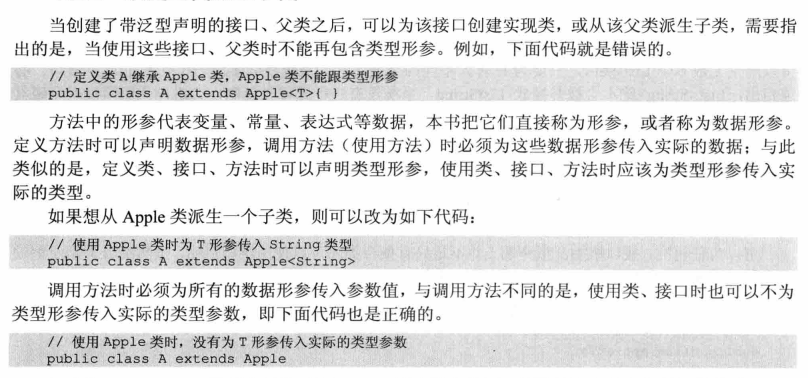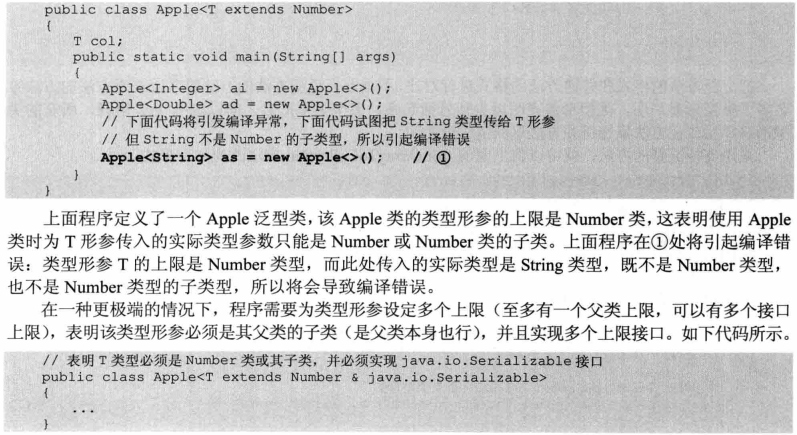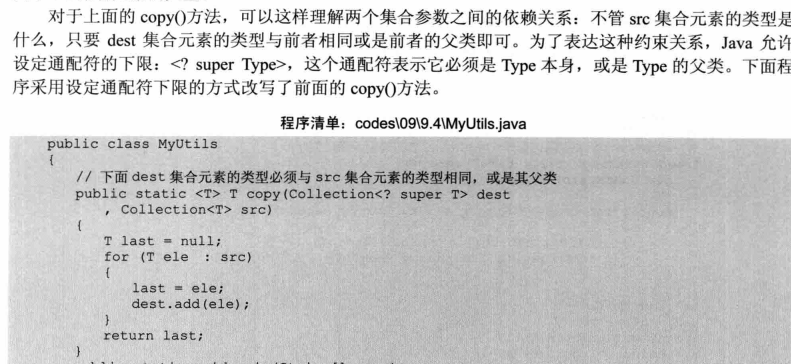目录
1.Generic概念

public static void main(String[] args) {
//Generic
List<String> l = new ArrayList<String>();
List<Integer> sl = Collections.synchronizedList(new ArrayList<Integer>());
l.add("aa");
sl.add(8);
//sl.add("8");泛型报错
System.out.println("List<String>" + l);
System.out.println("List<Integer>" + sl);
//Generic 简写
Map<String, Float> sm = Collections.synchronizedMap(new HashMap<>());
sm.put("Hello", 1f);
System.out.println("sm" + sm);
Map<Double, List<String>> smm = Collections.synchronizedMap(new HashMap<>());
smm.put(2.0, l);
//smm.putAll(2.0, sl);泛型报错
}
2.泛型类
2.1定义泛型类
定义泛型:
class 类名<声明自定义泛型>{
}
注意要点
- 在类上自定义泛型,具体数据类型在使用该类创建对象时候确定的
- 如果一个类在声明中指定了自定义泛型,如果使用该类创建对象时候没有指定具体的泛型数据类型,默认为Object
- 在类上自定义泛型不能作用于静态方法,如果静态方法需要使用自定义泛型,需要在方法上声明:static
void funStatic(T t){}
package com.company.project.generictext;
//GenericApple.java
public class GenericApple<T> {
private T tInfo;
//构造
public GenericApple(){}
public GenericApple(T tInfo){
this.tInfo = tInfo;
}
//getter & setter
public T gettInfo() {
return tInfo;
}
public void settInfo(T tInfo) {
this.tInfo = tInfo;
}
}
package com.company.project.generictext;
//GenericApplePrint.java
public class GenericApplePrint {
public static void main(String[] args) {
// TODO Auto-generated method stub
//传入给T形参是String,所以构造只能为String
GenericApple<String> gaString = new GenericApple<>("asdf");
System.out.println(gaString.gettInfo());
//传入给T形参是Integer,所以构造只能为Integer
GenericApple<Integer> gaInteger = new GenericApple<>(6);
System.out.println(gaInteger.gettInfo());
}
}
2.2泛型类的继承

package com.company.project.generictext;
//GenericAppleSubClass
public class GenericAppleSubClass extends GenericApple<String> {
}
2.3类型通配符
如果要定义一个通用的泛型子类,那么在继承中子类并不是父类的子类型,而数组是:

package com.company.project.upper;
//Shape.java
public abstract class Shape {
public abstract void draw(Canvas c);
}
package com.company.project.upper;
//Circle.java
public class Circle extends Shape {
@Override
public void draw(Canvas c) {
// TODO Auto-generated method stub
System.out.println("draw a circle on the canvas.");
package com.company.project.upper;
//Canvas.java
import java.util.List;
public class Canvas {
public void drawAll(List<? extends Shape> Shapes){
for (Shape s : Shapes) {
s.draw(this);
}//for
}
}
package com.company.project.upper;
//UpperPrint.java
import java.util.ArrayList;
import java.util.List;
public class UpperPrint {
public static void main(String[] args) {
// TODO Auto-generated method stub
List<Circle> l = new ArrayList<>();
Canvas c = new Canvas();
Circle ci = new Circle();
l.add(ci);
c.drawAll(l);
}
}

2.4设置类型形参上下限

要使用泛型通配符‘?’,并且这个通配符不会单独使用:
上限
////只存储Integer和Integer的子类
void Fun1(Collection <? extends Integer> c){
}
下限
//只存储Integer和Integer的父类
void Fun2(Collection <? super Integer> c){
}
2.5泛型接口
定义方法
interface 接口名称<自定义泛型>{
}
注意要点
- 接口上实现自定义泛型,具体数据类型是在 实现一个接口时候指定的
- 在接口上自定义泛型,如果在实现接口时候没有指定具体数据类型,那么默认为Object
- 如果要延长接口自定义泛型,那么类如下
class MyClass<T> implements MyInterface<T>{
}
3.泛型方法

package com.company.project.generictext;
import java.util.Collection;
//GenericMethod。java
public class GenericMethod {
//GM-1
static void fromArryaToCollection1(Object[] o, Collection<Object> c){
for (Object oo : c) {
c.add(oo);
}
}
//GM-2
//GenericMethod的:修饰符 <T> 返回类型 方法名称(形参表)
static <T> void fromArrayToCollection2(T[] t, Collection<T> c){
for (T t2 : c) {
c.add(t2);
}
}
//错误的拷贝
static <T> void fromArrayToCollection3(Collection<T> from, Collection<T> to){
for (T t : from) {
//这里程序不识别
to.add(t);
}
}
//要用继承去拷贝
static <T> void fromArrayToCollection4(Collection<? extends T> from, Collection<T> to){
for (T t : from) {
//这里程序不识别
to.add(t);
}
}
}
public static void main(String[] args) {
/*GM-1 print*/
String[] s = {"1", "a"};
HashSet<String> hs = new HashSet<>();
GenericMethod gm = new GenericMethod();
//Collection<String>不是Collection<Object>的子类,这里会编译错误
gm.fromArryaToCollection1(s, hs);
/*GM-2 print*/
Collection<String> cs = new HashSet<>();
//这里的T表示String
gm.fromArrayToCollection2(s, cs);
Integer[] i = new Integer[10];
Collection<Number> cn = new ArrayList<>();
//这里的T表示Number
gm.fromArrayToCollection2(i, cn);
}
4.类型通配符和泛型方法的区别
大多数时候都可以泛型方法替换类型通配符,如Java中:

5.设置类型通配符的下限

6.擦除和转换
泛型只在编译期间有效,运行时候是没有泛型的。
//这两个函数是重载,可以
public void Fun(Person p){
}
public void Fun(Emplooe p){
}
//这里会报错!因为编译后是同样的函数名称和入参
public void Fun(List<Person> p){
}
public void Fun(List<Emplooe> p){
}
7.泛型和数组
